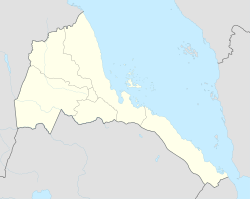Senafe
| Senafe | ||
|---|---|---|
|
|
||
| Coordinates | 14 ° 42 ' N , 39 ° 25' E | |
| Basic data | ||
| Country | Eritrea | |
| Semienawi Kayih Bahri | ||
| ISO 3166-2 | ER-SK | |
Senafe ( Arabic صنعفي) is a market town in southern Eritrea , on the edge of the Ethiopian highlands . The region is inhabited by the Saho people.
Senafe is known for the ruins of Metera (also known as Balaw Kalaw ), the rock church of Enda-Tradqan and the monastery of Debre Libanos (built in the sixth century).
history
The original name of the city was Hakir. Local history says that the current name goes back to a man named Abdulla from Sanaa in Yemen . He is believed to have lived in the Awdie neighborhood of Hakir and married a local woman, saying Sana-fen at the wedding - "where is Sanaa" in Arabic - referring to his hometown. His descendants form a tribe called Saanafè.
A map from 1454 shows Senafe on the outskirts of Tigray , connected by roads to Aksum in the west and Ashangisee in the south.
Senafe is mentioned in a land grant document from 1794/95 to Ras Wolde Selassie by the Ethiopian Emperor Tekle Giyorgis .
According to Clements Markham , who visited the area as part of the British Expedition to Ethiopia in 1868 , Senafe had about 240 residents who lived in a dozen houses. AJ Shepherd described the town in 1869 as "twelve to fourteen beehive-shaped buildings and as many small granaries". During the Italian rule over Eritrea the city grew, in 1891 Alamanni estimated the population at 1500. By 1938 the population is said to have risen to 2000.
At the beginning of the Italo-Ethiopian War , the troops of the Ethiopian governor of Tigray suffered a serious defeat in the Battle of Senafe (1895). Senafe was later badly damaged during the Eritrean War of Independence and the Eritrean-Ethiopian War .

